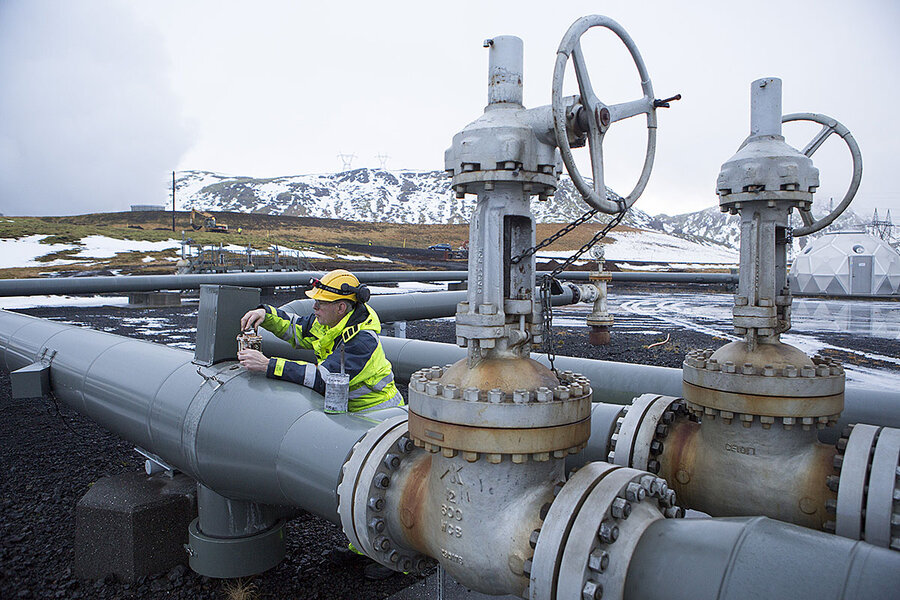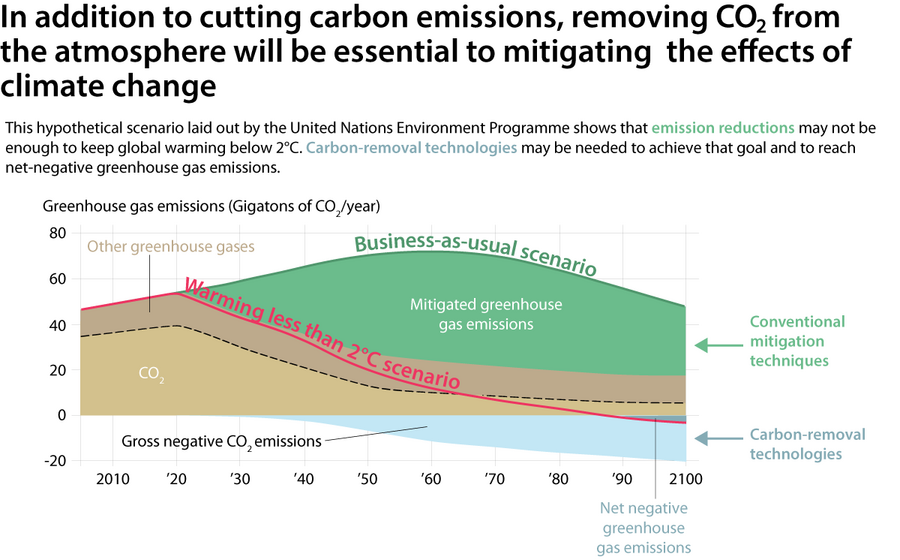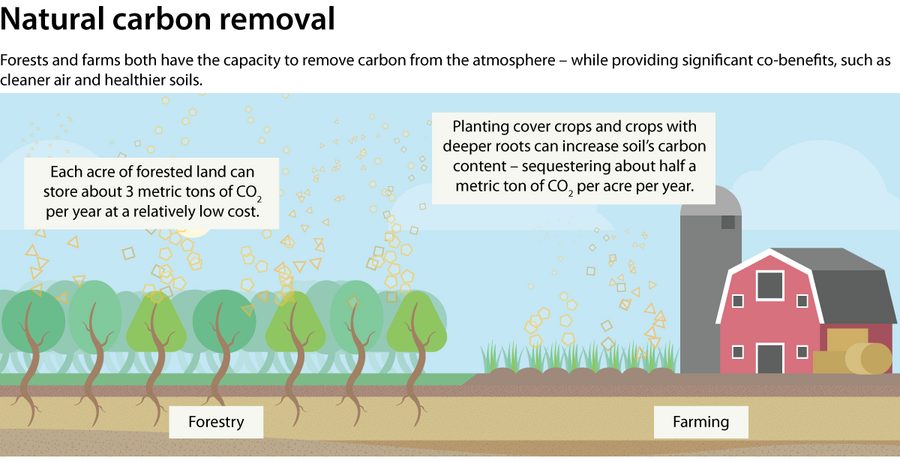Cutting emissions still matters. But carbon capture rises as a battlefront.
Loading...
| Boulder, Colo.
Emissions reduction plays a key role in plans to limit global warming to 1.5 or 2 degrees C. But increasingly, experts say that reduction alone won’t be enough. Removing carbon dioxide from the atmosphere is also necessary. Luckily, our understanding of how to do that effectively is rapidly growing – even if most of the means to do so still have big challenges or drawbacks. Some carbon removal relies entirely on biology, such as using the natural potential that forests and farms have as carbon sinks. Others – like capturing carbon dioxide directly from the air before storing it geologically – harness technology. Experts say these technologies have big potential, but also a long way to go before they can be cost-effective or deployed at a large scale. Carbon removal “is at an interesting inflection point,” says Noah Deich, executive director of Carbon180, a nonprofit that aims to change the way we think about carbon. Now, he says, “it’s about moving from conversation to action.”
Why We Wrote This
Climate mitigation strategies tend to focus on emissions reduction. But carbon capture is becoming an equally vital prong of climate action. And the technology to do it is rapidly catching up.
By now, virtually everyone knows something about the need to curb emissions if we have any hope of keeping global warming in check. But what about actually removing carbon dioxide from the atmosphere?
Increasingly, carbon removal is becoming an important part of the conversation – and many experts say it’s a necessary part of any plan to keep global temperature rise below 1.5 degrees, or even 2 degrees, C. And the technology to accomplish it is rapidly advancing.
“The first rule of holes is to stop digging,” says Noah Deich, executive director of Carbon180, referring to the need to lower emissions. “But we can’t just stay down in the hole, we’ve got to climb our way out…. We have to figure out how strategies on the removal side can complement what we’re doing on mitigation.”
Why We Wrote This
Climate mitigation strategies tend to focus on emissions reduction. But carbon capture is becoming an equally vital prong of climate action. And the technology to do it is rapidly catching up.
Some of the means to do that are entirely natural: Forests and farms, managed the right way, can both be carbon sinks. Others are technological: Bioenergy with carbon capture and storage – better known as BECCS – converts biomass into outputs like heat or biofuel and captures and stores the carbon dioxide emitted in the process, either underground or in products like concrete or plastics. Direct air capture and storage scrubs carbon dioxide out of ambient air, often using a chemical adsorbent to separate the carbon dioxide, before storing or using it.
And a suite of other nascent technologies is slowly emerging: A technique known as enhanced weathering accelerates natural reactions between certain minerals and carbon dioxide. Seawater capture extracts carbon dioxide from the oceans. Plant engineering involves selectively breeding certain plants for traits that increase carbon storage in soils.
All those options have potential, as well as significant challenges, says James Mulligan, an associate at the World Resources Institute and lead author on a series of papers that the WRI just released on carbon removal. It’s one reason he and others favor a portfolio approach: pursuing each of those options at a scale and a manner that make sense, investing in research and development to further our understanding or drive down costs, and not seeing any one carbon-removal strategy as a silver bullet.
A range of options
Some of the biological means of removing carbon – reforestation and managing forests to maximize their use as carbon sinks, planting some trees on agricultural and grazing lands, and managing farms to capture more carbon in the soils – are an obvious place to focus energy first, says Mr. Mulligan.
“They’re easier to do now, and they generally have very good co-benefits,” says Mulligan. One of the biggest downsides is that the carbon storage isn’t necessarily permanent: Forests can burn down; soils can release their carbon with changes in climate. But many of the climate-friendly practices also boost soil health, aid in biodiversity conservation, and engage rural communities in meaningful ways in climate action.
“I view the land-measures side as really critical in buying us time,” says Mulligan.
But other efforts to remove carbon from the atmosphere – including direct air capture – are rapidly advancing, and experts say they’re no longer the aspirational or theoretical models that some people used to consider them.
That isn’t to say there aren’t real challenges. BECCS has potential – but requires better and cheaper carbon-capture technology, and would require a lot of sustainable biomass to do it at scale. “It’s challenging to do BECCS right, and when it comes to bioenergy, we’ve done it wrong in the past,” says Deich.
Both Mulligan and Deich say they’re particularly excited about the future potential of direct air capture, since if the costs come down, there’s no real ceiling to how much carbon could be captured. Several companies doing direct air capture already exist. Still, the technology for direct air capture and storage isn’t as far along, and at this point, the costs are high. It also requires a lot of energy, which would need to be carbon-neutral.
A matter of time?
Mulligan, for one, sees an analogy between the carbon-removal technologies and solar energy, which, decades ago, was also cost-prohibitive and only used at a small scale.
Given public incentives – like some kind of carbon-pricing system – and a real investment in research and development, he believes the cost and the scalability of all these options could improve rapidly.
“It’s about getting them to the place where they’re cheap enough, and we know well enough how they work, and how they can be deployed safely and prudently,” says Mulligan. “So that, when we’re ready to start paying $50 or $100 or $150 a ton for that service, there are options on the table and we know how to deploy them.”
Last week, just before the Global Climate Action Summit in San Francisco, California Gov. Jerry Brown committed the state to carbon neutrality by 2045 and “net negative emissions thereafter.” It was a public recognition that just reducing emissions won’t be enough, and a stated hope – enshrined in executive order – that the technology by that point will be far enough along to deploy many of these technologies at a meaningful scale.
Carbon removal “is at this interesting inflection point,” says Deich. “I think we’re going to see countries and governments and organizations all around the world start to see [net negative emissions] as the benchmark. At the same time, nobody really has a plan as to how we’re going to make that happen… It’s about moving from conversation to action.”











